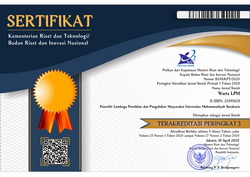Peningkatan Pengetahuan tentang Cara Melakukan Latihan Fisik atau Olah Raga yang Aman Bagi Penderita Diabetes Mellitus
DOI:
https://doi.org/10.23917/warta.v26i2.1247Keywords:
diabetes mellitus, safe excercise, life qualityAbstract
Diabetes mellitus is a progressive chronic disease. DM is a disease with the category of non-communicable disease or a disease that is not caused by an infectious disease. Prolonged hyperglycemia has an impact on the development of microvascular and macrovascular complications, resulting in various problems, dissability and decreased quality of life. Regular and safe physical exercise is a therapy that can reduce glucose. However, not all people with diabetes are allowed to exercise. There are several provisions that must be observed to avoid side effects after exercise, such as hypoglycemia. Because DM is a disease with metabolic disorders, it is possible for patients to have complications, such as hypertension and coronary heart disease as common complications of DM. Not all people with DM understand the provisions that must be considered before doing exercise. Therefore, counselling is the most appropriate activity to provide information to patients with DM about the provisions that have to be considered before exercising. Counselling activities are expected to be followed up by patients with DM to do physical exercise or sports regularly and pay attention to their own condition. So that it can reduce the risk of developing DM and its complications and improve the quality of life of patients with DM.
References
Ahmad, I., Verma, S., Noohu, M. M., Shareef, M. Y., & Hussain, M. E. (2020). Sensorimotor and gait training improves proprioception, nerve function, and muscular activation in patients with diabetic peripheral neuropathy: a randomized control trial. J Musculoskelet Neuronal Interact, 20(2), 234-248.
Balk, E. M., Earley, A., Raman, G., Avendano, E. A., Pittas, A. G., & Remington, P. L. (2015). Combined Diet and Physical Activity Promotion Programs to Prevent Type 2 Diabetes Among Persons at Increased Risk: A Systematic Review for the Community Preventive Services Task Force. Ann Intern Med, 163(6), 437-451. doi:10.7326/m15-0452
Bokan-Mirkovic, V., Skaric-Karanikic, Z., Nejkov, S., Vukovic, M., & Cirovic, D. (2017). Diabetic Polyneuropathy and Risk of Falls: Fear of Falling and Other Factors. Acta Clin Croat, 56(4), 721-727. doi:10.20471/acc.2017.56.04.20
Brown, S. J., Handsaker, J. C., Bowling, F. L., Boulton, A. J., & Reeves, N. D. (2015). Diabetic peripheral neuropathy compromises balance during daily activities. Diabetes Care, 38(6), 1116-1122. doi:10.2337/dc14-1982
Chen, L., Pei, J. H., Kuang, J., Chen, H. M., Chen, Z., Li, Z. W., & Yang, H. Z. (2015). Effect of lifestyle intervention in patients with type 2 diabetes: a meta-analysis. Metabolism, 64(2), 338-347. doi:10.1016/j.metabol.2014.10.018
Colberg, S. R., Laan, R., Dassau, E., & Kerr, D. (2015). Physical activity and type 1 diabetes: time for a rewire? J Diabetes Sci Technol, 9(3), 609-618. doi:10.1177/1932296814566231
Colberg, S. R., Sigal, R. J., Yardley, J. E., Riddell, M. C., Dunstan, D. W., Dempsey, P. C., . . . Tate, D. F. (2016). Physical Activity/Exercise and Diabetes: A Position Statement of the American Diabetes Association. Diabetes Care, 39(11), 2065-2079. doi:10.2337/dc16-1728
Coyle, M. E., Francis, K., & Chapman, Y. (2013). Self-management activities in diabetes care: a systematic review. Aust Health Rev, 37(4), 513-522. doi:10.1071/ah13060
Deng, Q., & Liu, W. (2020). Physical Exercise, Social Interaction, Access to Care, and Community Service: Mediators in the Relationship Between Socioeconomic Status and Health Among Older Patients With Diabetes. Front Public Health, 8, 589742. doi:10.3389/fpubh.2020.589742
Duclos, M., Virally, M.-L., & Dejager, S. (2011). Exercise in the Management of Type 2 Diabetes Mellitus: What Are the Benefits and How Does it Work? The Physician and sportsmedicine, 39, 98-106. doi:10.3810/psm.2011.05.1899
Fasil, A., Biadgo, B., & Abebe, M. (2019). Glycemic control and diabetes complications among diabetes mellitus patients attending at University of Gondar Hospital, Northwest Ethiopia. Diabetes Metab Syndr Obes, 12, 75-83. doi:10.2147/dmso.S185614
Feldman, E. L., Callaghan, B. C., Pop-Busui, R., Zochodne, D. W., Wright, D. E., Bennett, D. L., . . . Viswanathan, V. (2019). Diabetic neuropathy. Nat Rev Dis Primers, 5(1), 42. doi:10.1038/s41572-019-0097-9
Forbes, J. M., & Cooper, M. E. (2013). Mechanisms of diabetic complications. Physiol Rev, 93(1), 137-188. doi:10.1152/physrev.00045.2011
Francescato, M. P., Stel, G., Stenner, E., & Geat, M. (2015). Prolonged exercise in type 1 diabetes: performance of a customizable algorithm to estimate the carbohydrate supplements to minimize glycemic imbalances. PLoS One, 10(4), e0125220. doi:10.1371/journal.pone.0125220
Gill, J. M., & Cooper, A. R. (2008). Physical activity and prevention of type 2 diabetes mellitus. Sports Med, 38(10), 807-824. doi:10.2165/00007256-200838100-00002
Guariguata, L., Whiting, D. R., Hambleton, I., Beagley, J., Linnenkamp, U., & Shaw, J. E. (2014). Global estimates of diabetes prevalence for 2013 and projections for 2035. Diabetes Res Clin Pract, 103(2), 137-149. doi:10.1016/j.diabres.2013.11.002
Hachem, A., & Brennan, L. (2016). Quality of Life Outcomes of Bariatric Surgery: A Systematic Review. Obes Surg, 26(2), 395-409. doi:10.1007/s11695-015-1940-z
Harding, J. L., Pavkov, M. E., Magliano, D. J., Shaw, J. E., & Gregg, E. W. (2019). Global trends in diabetes complications: a review of current evidence. Diabetologia, 62(1), 3-16. doi:10.1007/s00125-018-4711-2
Heinemann, L., Nosek, L., Kapitza, C., Schweitzer, M. A., & Krinelke, L. (2009). Changes in basal insulin infusion rates with subcutaneous insulin infusion: time until a change in metabolic effect is induced in patients with type 1 diabetes. Diabetes Care, 32(8), 1437-1439. doi:10.2337/dc09-0595
Hernandez-Tejada, M. A., Campbell, J. A., Walker, R. J., Smalls, B. L., Davis, K. S., & Egede, L. E. (2012). Diabetes empowerment, medication adherence and self-care behaviors in adults with type 2 diabetes. Diabetes Technol Ther, 14(7), 630-634. doi:10.1089/dia.2011.0287
Johnson, L. R., Rush, J. W., Turk, J. R., Price, E. M., & Laughlin, M. H. (2001). Short-term exercise training increases ACh-induced relaxation and eNOS protein in porcine pulmonary arteries. J Appl Physiol (1985), 90(3), 1102-1110. doi:10.1152/jappl.2001.90.3.1102
Komalasari, D. R., Vongsirinavarat, M., Hiengkaew, V., & Nualnim, N. (2022). The Adaptation of Participation Scale Short Simplified Questionnaire into Indonesian Language and the Psychometric Properties in Individuals with Type 2 Diabetes Mellitus with Vestibular Dysfunction. Rehabil Res Pract, 2022, 2565833. doi:10.1155/2022/2565833
MacMillan, F., Kirk, A., Mutrie, N., Matthews, L., Robertson, K., & Saunders, D. H. (2014). A systematic review of physical activity and sedentary behavior intervention studies in youth with type 1 diabetes: study characteristics, intervention design, and efficacy. Pediatr Diabetes, 15(3), 175-189. doi:10.1111/pedi.12060
Maiorana, A., O'Driscoll, G., Taylor, R., & Green, D. (2003). Exercise and the nitric oxide vasodilator system. Sports Med, 33(14), 1013-1035. doi:10.2165/00007256-200333140-00001
Moghetti, P., Bacchi, E., Brangani, C., Donà, S., & Negri, C. (2016). Metabolic Effects of Exercise. Front Horm Res, 47, 44-57. doi:10.1159/000445156
P2PTM. (2020). Infodatin-2020-Diabetes Mellitus Tetap Produkti, Cegah dan Atasi Diabetes Mellitus. Retrieved from https://pusdatin.kemkes.go.id website:
Purwanti, O. S., & Novitasari, E. (2021). The correlation of knowledge of prevention with neuropathy treatment in diabetes mellitus patients in Sukoharjo regency. Bali Medical Journal, 10(3), 1342-1346.
Riddell, M. C., & Milliken, J. (2011). Preventing exercise-induced hypoglycemia in type 1 diabetes using real-time continuous glucose monitoring and a new carbohydrate intake algorithm: an observational field study. Diabetes Technol Ther, 13(8), 819-825. doi:10.1089/dia.2011.0052
Russell, J. W., & Zilliox, L. A. (2014). Diabetic neuropathies. Continuum (Minneap Minn), 20(5 Peripheral Nervous System Disorders), 1226-1240. doi:10.1212/01.CON.0000455884.29545.d2
Sacco, I. C., & Amadio, A. C. (2003). Influence of the diabetic neuropathy on the behavior of electromyographic and sensorial responses in treadmill gait. Clin Biomech (Bristol, Avon), 18(5), 426-434. doi:10.1016/s0268-0033(03)00043-3
Salas, M., Bubolz, T., & Caro, J. J. (2000). Impact of physical functioning of health status on hospitalizations, physician visits, and costs in diabetic patients. Arch Med Res, 31(2), 223-227.
Sanz, C., Gautier, J. F., & Hanaire, H. (2010). Physical exercise for the prevention and treatment of type 2 diabetes. Diabetes Metab, 36(5), 346-351. doi:10.1016/j.diabet.2010.06.001
Saxton, S. N., Clark, B. J., Withers, S. B., Eringa, E. C., & Heagerty, A. M. (2019). Mechanistic Links Between Obesity, Diabetes, and Blood Pressure: Role of Perivascular Adipose Tissue. Physiol Rev, 99(4), 1701-1763. doi:10.1152/physrev.00034.2018
Schwartz, A. V., Vittinghoff, E., Sellmeyer, D. E., Feingold, K. R., de Rekeneire, N., Strotmeyer, E. S., . . . Harris, T. B. (2008). Diabetes-related complications, glycemic control, and falls in older adults. Diabetes Care, 31(3), 391-396. doi:10.2337/dc07-1152
Shrivastava, S., Shrivastava, P., & Ramasamy, J. (2013). Role of self-care in management of diabetes mellitus. J Diabetes Metab Disord, 12, 14. doi:10.1186/2251-6581-12-14
Sleath, B., Carpenter, D. M., Blalock, S. J., Davis, S. A., Hickson, R. P., Lee, C., . . . Cummings, D. M. (2016). Development of a new diabetes medication self-efficacy scale and its association with both reported problems in using diabetes medications and self-reported adherence. Patient Prefer Adherence, 10, 1003-1010. doi:10.2147/ppa.S101349
Sulistyaningsih, S., & Listyaningrum, T. H. J. W. L. (2021). Deteksi Faktor Risiko Penyakit Tidak Menular melalui Pos Pembinaan Terpadu Warga Sehat di Era Pandemi Covid-19. Warta LPM, 24(3), 558-570.
Tuttle, L. J., Sinacore, D. R., Cade, W. T., & Mueller, M. J. (2011). Lower physical activity is associated with higher intermuscular adipose tissue in people with type 2 diabetes and peripheral neuropathy. Phys Ther, 91(6), 923-930. doi:10.2522/ptj.20100329
Watt, A., Beacham, A., Palmer-Mann, L., Williams, A., White, J., Brown, R., . . . Paisey, R. (2021). Service user and community clinician design of a partially virtual diabetic service improves access to care and education and reduces amputation incidence. BMJ Open Diabetes Res Care, 9(1). doi:10.1136/bmjdrc-2020-001657
WHO. (2011). WHO Guidelines Approved by the Guidelines Review Committee. In Use of Glycated Haemoglobin (HbA1c) in the Diagnosis of Diabetes Mellitus: Abbreviated Report of a WHO Consultation. Geneva: World Health Organization. 2011
WHO. (2016). Global report on diabetes
WHO. (2020). Physical Activity Facts and figures, 1-13.
Yokobayashi, K., Kawachi, I., Kondo, K., Kondo, N., Nagamine, Y., Tani, Y., . . . Tazuma, S. (2017). Association between Social Relationship and Glycemic Control among Older Japanese: JAGES Cross-Sectional Study. PLoS One, 12(1), e0169904. doi:10.1371/journal.pone.0169904
Zhai, Y., & Yu, W. (2020). A Mobile App for Diabetes Management: Impact on Self-Efficacy Among Patients with Type 2 Diabetes at a Community Hospital. Med Sci Monit, 26, e926719. doi:10.12659/msm.926719
Zheng, Y., Ley, S. H., & Hu, F. B. (2018). Global aetiology and epidemiology of type 2 diabetes mellitus and its complications. Nat Rev Endocrinol, 14(2), 88-98. doi:10.1038/nrendo.2017.151
Downloads
Submitted
Accepted
Published
How to Cite
Issue
Section
License
Copyright (c) 2023 Warta LPM

This work is licensed under a Creative Commons Attribution 4.0 International License.















